
Ducks and ponds
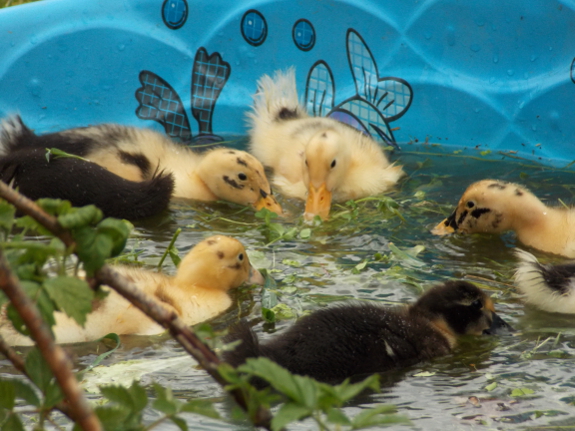
It's been six whole days since we last posted about our ducklings. I know you must all be in withdrawal!
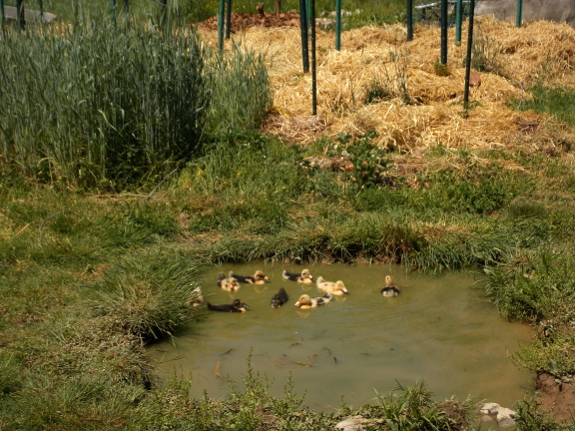
More seriously, we've
learned a lot over the past week, so it's time for another photo-rich
post. The first thing we learned is --- our sky pond does hold
water!
 Why
do I sound so surprised? In a linerless pond, you don't really
know right away whether your sealing method worked since it takes time
for all of the little leaks to stop themselves up. As a result, I
wasn't sure whether my foot-stomped gleying
did its job, or whether the pond surface was just reflecting the
surrounding groundwater levels. All winter, the pond waxed and
waned with the weather, so I suspected my gleying hadn't done anything.
Why
do I sound so surprised? In a linerless pond, you don't really
know right away whether your sealing method worked since it takes time
for all of the little leaks to stop themselves up. As a result, I
wasn't sure whether my foot-stomped gleying
did its job, or whether the pond surface was just reflecting the
surrounding groundwater levels. All winter, the pond waxed and
waned with the weather, so I suspected my gleying hadn't done anything.
When the sky pond dipped
down to about six inches below ground level early this week, Mark
suggested I fill it up with a hose. This was a good test of the
water-tightness of the seal since the groundwater has descended quite
low in the absence of rain. Thus, if the pond wasn't sealed, I
would expect the water I added to the pond to quickly drain away.
Instead, twenty-four hours after filling, the pond was pretty much the
same depth as when I turned the hose off! It looks like the sky
pond might really be turning into a pond rather than a simple hole in
the ground.
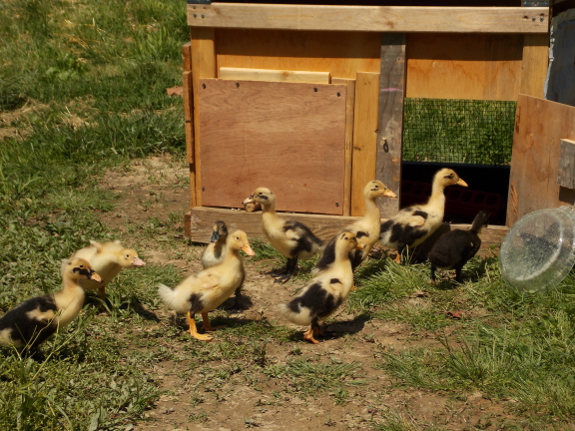
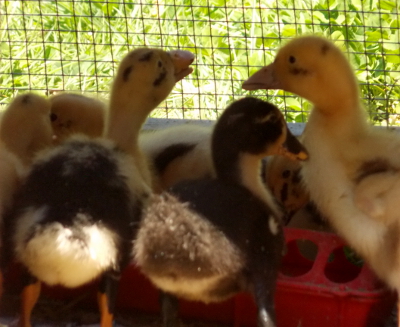 The
next thing I learned was more duck-related. When we posted last
weekend about letting the ducklings out into the sky pond, several of
you commented to ask how we'd get them back into the brooder at
night. Although our ducklings did
pop out of the water a few times a day to dine inside, our readers were
right --- they would have rather slept on the water rather than in
their safe little coop. However, a little bit of gentle herding
(with a stick or a second person to channel the waterfowl toward the
open door) was sufficient to get them into the brooder each night.
Ducklings are definitely harder to herd than chickens (despite what
books say), but shutting them in is quite feasible.
The
next thing I learned was more duck-related. When we posted last
weekend about letting the ducklings out into the sky pond, several of
you commented to ask how we'd get them back into the brooder at
night. Although our ducklings did
pop out of the water a few times a day to dine inside, our readers were
right --- they would have rather slept on the water rather than in
their safe little coop. However, a little bit of gentle herding
(with a stick or a second person to channel the waterfowl toward the
open door) was sufficient to get them into the brooder each night.
Ducklings are definitely harder to herd than chickens (despite what
books say), but shutting them in is quite feasible.
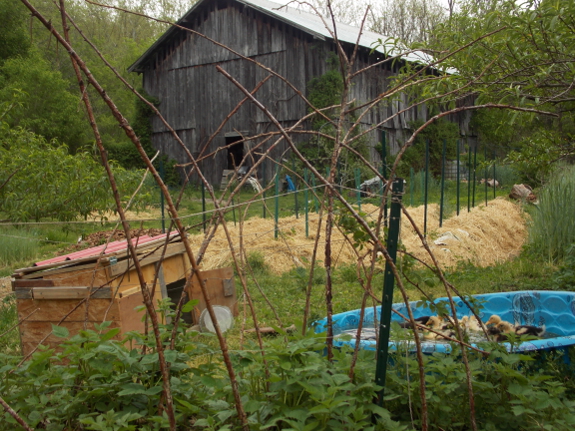
For the first few days,
the ducks didn't get out of the sky pond until I made them, but then the
duckweed and water bugs gave out and our waterfowl started to spend
more time on the bank. Soon, the little flock realized that
strawberries were only two feet 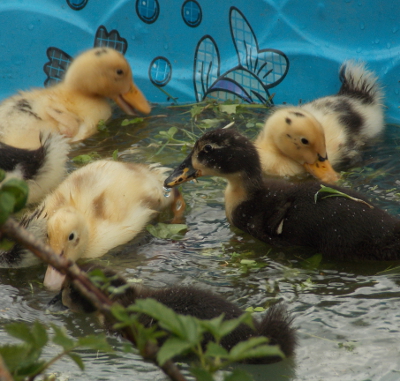 from the shore and they began to peck hungrily at the green fruit. That was my cue to move them to a new spot.
from the shore and they began to peck hungrily at the green fruit. That was my cue to move them to a new spot.
The kiddie pool had only
enjoyed about a week of duck-weed-growing time, so I was a bit afraid
the sterile surroundings wouldn't hold their interest. But our
ducklings told me that water is water --- they were happy. They
were even happier once I tossed in an armload of tender weeds from the
garden, giving the youngsters something to play with.
Mark wanted to know what
the big picture plan is --- how long will the ducklings be living in the
backyard? When will they go to the starplate coop with this
year's young pullets? The answer is --- I don't know. It all
depends on how well they play with the garden. I'll keep you
posted and will regale you with far too many photos again before you
know it.
Want more in-depth information? Browse through our books.
Or explore more posts by date or by subject.
About us: Anna Hess and Mark Hamilton spent over a decade living self-sufficiently in the mountains of Virginia before moving north to start over from scratch in the foothills of Ohio. They've experimented with permaculture, no-till gardening, trailersteading, home-based microbusinesses and much more, writing about their adventures in both blogs and books.
Want to be notified when new comments are posted on this page? Click on the RSS button after you add a comment to subscribe to the comment feed, or simply check the box beside "email replies to me" while writing your comment.

They are much easier to herd than Chickens if you do it right.
First they are very timid like I mentioned so they spook easily. All you have to do is move slowly. Do not make sudden moves. Walk behind them and guide them to where you want them to go. Use your arms to guide them ... right arm to go left, and left arm to go right. Or use a broom but move it slowly not radically.
Edith
Edith --- I think that, perhaps, I'm just really good at herding chickens. I find chickens quite easy to move along at a walking pace using the same methods you mentioned (but with the addition of a long stick so my arms seem longer). However, with ducks , I have to go really, really slooowly not to scare them. That's why I say ducks are harder --- you have to be more careful with them.
Juniper and Brandy --- I agree. Definitely still cute, although looking more like ducks and less like ducklings.